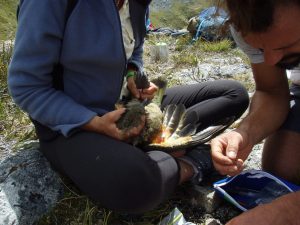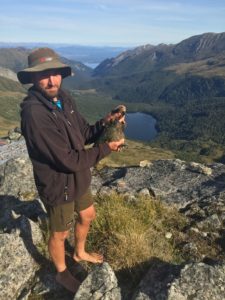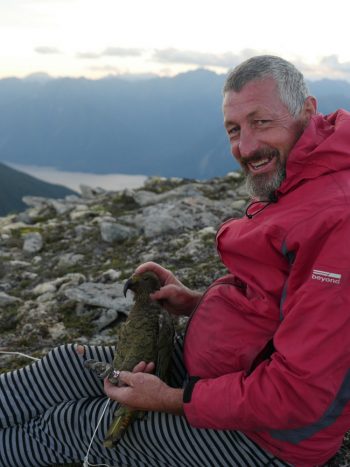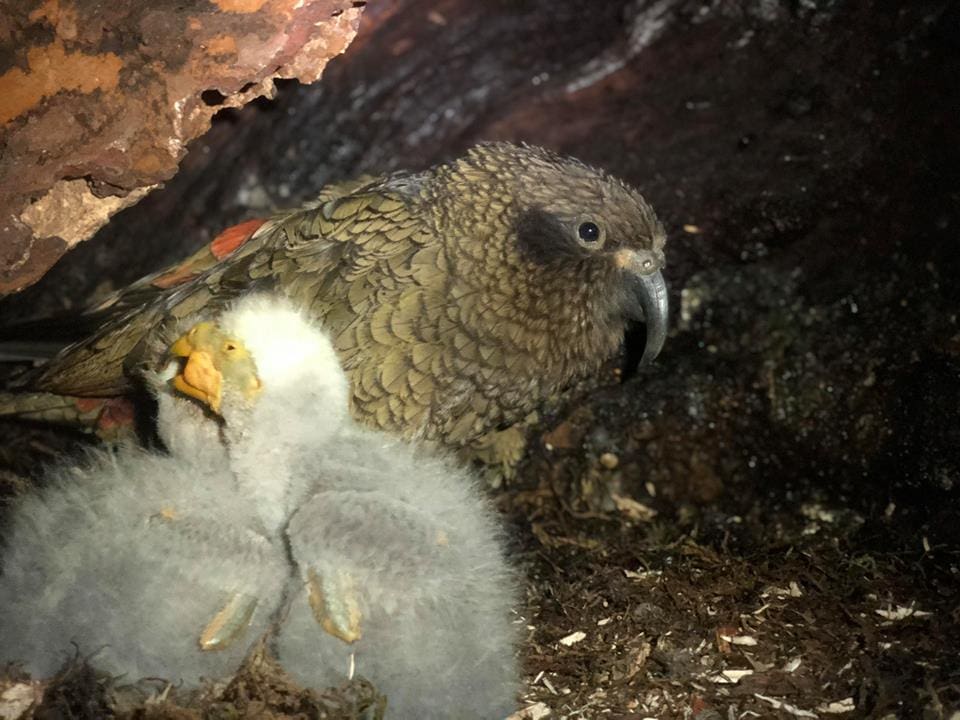Funded by Paradise Valley Springs, Clever Kiwis, Denver Zoo, "Name a Kea" donors and Nga Whenua Rahui
This multi-year project is building on the Community – kea project plan (funded by DOC) and Fiordland kea sightings project initiated in partnership with the Fiordland Wapiti Foundation (FWF) in March 2016.
The broader monitoring of kea in Fiordland NP project has 3 main aims: i) run an annual community (FWF) kea survey in March-April, ii) run a formal summer kea population survey and catch trip annually (year 1) to enable attachment of transmitters and bands to adult females and bands to adult males, fledglings and juveniles (beginning January 2018), and iii) monitor kea nest productivity and predator impact through the following breeding seasons and develop a predator control grid network as necessary. All data collected will be analysed to establish a baseline for the local kea population and to develop a sustainable community protection programme for Fiordland kea.
Conservation Issue
This project is important for kea conservation efforts for the following reasons; i) little is known about the population status of kea in the Fiordland NP, ii) this area has expressed extensive, ongoing commitment by the local community (Fiordland Wapiti Foundation and membership), iii) kea are considered an important species to the wider community and concern has been raised as to anecdotal reports of decreasing numbers and iv) there is currently no management or support directed towards local kea populations.

Little is known about the Fiordland kea population. A 3 year population survey covering approximately 4,000 ha, was conducted in the Borland Valley in January 2009, 2011 and 2012. This area has no pest control programmes in place. A total of 17 kea were caught up over the 3 years (7 adult males, 3 adult females, 6 subadult males and 1 fledgling). A total of 8 transmitters were attached (2011 and 2012). Follow up nest monitoring occurred in 2009, 2011 and 2012 but was hampered due to high snowfall closing the Borland Rd and difficulty locating nests. Overall, kea sightings and fledglings produced were significantly lower than other survey sites (Nelson Lakes and the Hawdon Valley in Arthur’s Pass).
The Fiordland NP contains prime kea habitat and large tracts of Wilderness areas. The Fiordland Wapiti Foundation runs the Wapiti ballot annually which covers an area of over 200,000 ha, half of which is a designated Wilderness area. Up to 450 hunters spend up to 10 days each across a month period (March – April) in this area and are committed to sending in sightings of kea across years due to concerns of declining kea populations in the area. This level of community support for kea in such an extensive area is one of a kind and makes this project particularly unique.
2021 Survey
Funded by ASAG
Surveys were carried out between 6-9am/pm from the 29th January through the 4th February whenever the weather allowed and six kea were caught and banded, including two adult females who were also fitted with transmitters. Nest cameras were collected from two nests and telemetry checks confirmed alive status for Nyx and Jo however no signal was found for Lydia, Mako or Sonoe.
2020 Survey
Funded by Wellington Zoo Conservation Fund, Wellington Zoo Conservation Fund, Milford Rd Coffee Cat.
Supported by Fiordland DOC and The Fiordland Wapiti Foundation.
The third year of this survey ran for 7 days from 6th February - 12th February inclusive.
- A total of 25 kea were caught which included 3 adult male, 7 fledglings (3 female and 4 male) and 15 juveniles ( 3 female and 12 male). All were banded and biodata recorded and entered into the kea database.
- No transmitters were attached (as no adult females caught).
- 10 kea blood lead tested. All levels were below 5.5μg/dL, with a mean of 3.1μg/dL. Testing from the last three years reveals that lead poisoning is not an issue for kea sampled in the Stuart Mountains.

All kea with transmitters fitted were active according to the pulse-rate received through handheld radio telemetry devices. No known adult females were nesting at this time.
Follow up monitoring
Follow up skyranger flights to check nesting activity ran from August and until December 2020.
2nd - 4th November
A tracking trip was carried out over three days and found signals for two kea (Nyx and Jo), neither of which were nesting. We were unable to gain signals for four other kea in the Stuarts (Mako, Lydia, Alana and Sonoe). This was for various reasons including suspected dead batteries, possible dispersal and interference with transmitter channels. Mako had been located on a tracking flight just prior to this trip.
2019 Survey
Funded by Paradise Valley Springs, Clever Kiwi Company, Nga Whenua Rahui, Denver Zoo, Wellington Zoo Conservation Fund and "Name a Kea" donors.
Supported by Fiordland DOC and the Fiordland Wapiti Foundation.
This years survey ran for only 2 days from the 17th to the 19th January 2019. The survey was cut short because of an unexpected extreme weather event which meant personnel had to be quickly evacuated. A total of 8 sites were surveyed covering an area of approximately 4,300ha of kea habitat in the Stuart Mountain Range.
- 33 kea were captured and banded with colour ID bands bringing the number of banded kea in this area to 73.
- Four new adult females had transmitters (Tx) attached bringing the total number of Tx females in this area to six and one adult male.
- 19 kea were blood lead tested. All had low levels (with a high of 13ug/dL).
Lydia, the female whose nest was found in 2018, was rechecked during the January survey and was still sitting on 3 very large chicks which were estimated to be about 2 weeks from fledging.
These females will be followed up over the 2019-2020 breeding season to ascertain breeding success.
Follow up monitoring
Two skyranger flights were carried out on the 11th Feb and 17th May to check the location of all females with transmitters attached. All 6 females were located and found to be active in February and 4 of the 6 females located during the May trip. Those birds which did not return a signal are likely to either be in a valley or out of the flight area at this time and will be followed up during subsequent flights.
2018 Survey
Funded by Paradise Valley Springs, Clever Kiwi Company and Nga Whenua Rahui.
Supported by Fiordland DOC and The Fiordland Wapiti Foundation.
The first of the kea survey trips ran for 8 nights in January 2018. 28 sites were surveyed for 3 hours each night and 3 hours each morning. 14 personnel made up the survey team (experienced kea handlers teamed up with volunteers from the Fiordland Wapiti Foundation, Nga Whenua Rahui and DOC).
- 44 kea were caught and banded during the survey period. The majority of kea were adults with a few subadults, 2 juveniles and only 2 fledglings.
- 2 adult females and 1 male were fitted with transmitters to allow for follow up nest monitoring this coming breeding season.
- 14 kea were blood lead tested. One of these had elevated lead levels (>20ug/dL), all others were low.

Follow up monitoring
Monitoring during the 2018 breeding season found 1 of the females, Lydia, sitting on an active nest with 3 chicks. These will be followed up on during the January 2019 survey to see whether they have survived to fledging.
Thank you to all of those people and organisations involved in this first year of the survey. We couldn't have done it without you!

Thank you to the following donors - we couldn't have done this work without your support!



